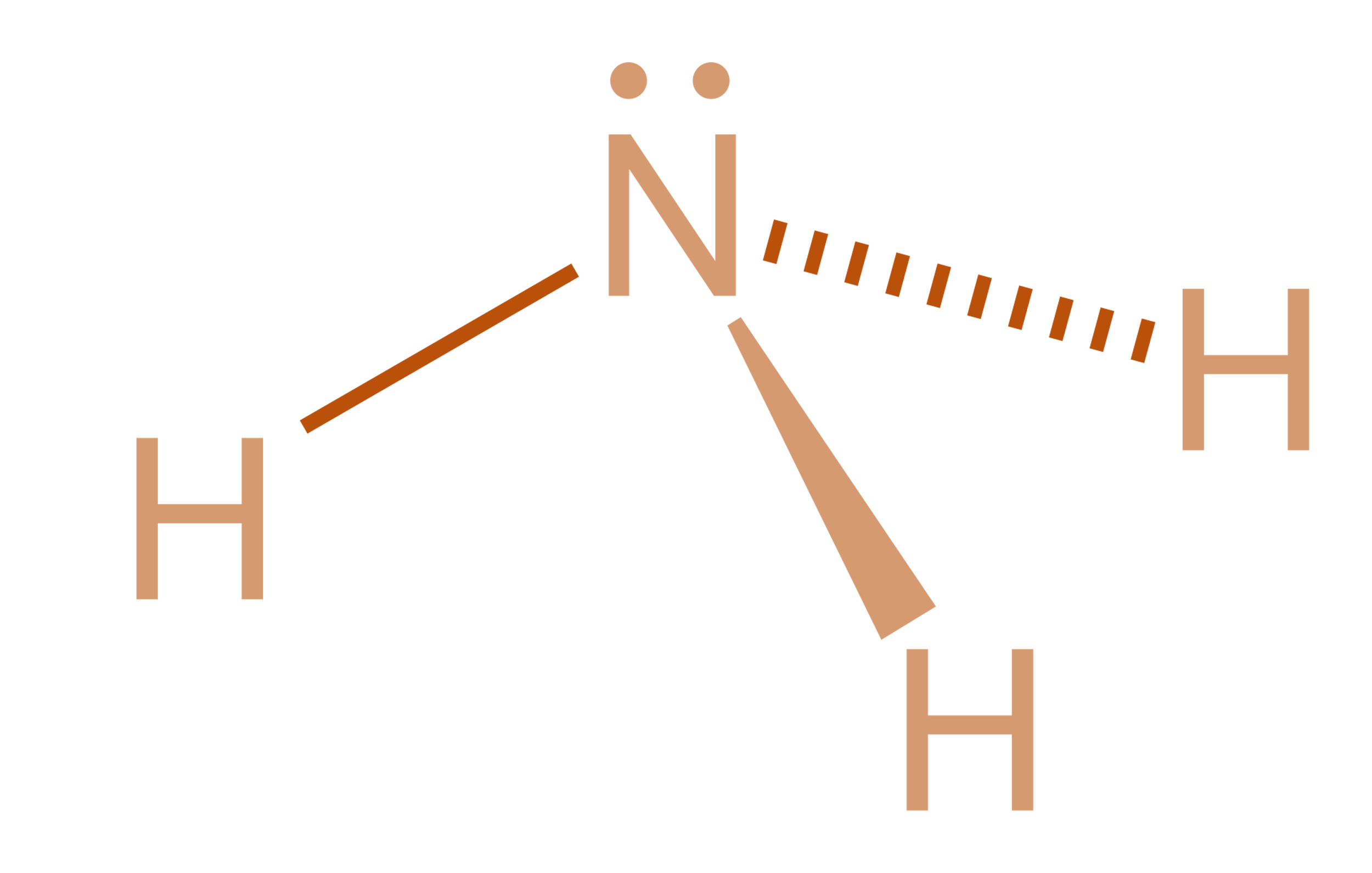
A molecule of ammonia $(N{H_3})$ has:
A. Only single bonds
B. Only double bonds
C. Only triple bonds
D. Two double bonds and one single bond
Answer
427.5k+ views
Hint: Ammonia molecule has \[A{B_3}\] molecular geometry with a lone pair in which the three hydrogen atoms and an unshared pair of electrons are attached to the central nitrogen atom.
Complete step-by-step solution:
Ammonia is a colourless gas, consisting of hydrogen and nitrogen. It has a pungent smell and it is dangerous in its concentrated form. It behaves as a weak base as it forms salts with many acids. Ammonia is also called azane or nitrogen trihydride. It is a polar molecule due to the presence of lone pairs and readily forms hydrogen bonds.
Ammonia is a covalent atom because of the overlap of orbitals of three hydrogen atoms and three \[s{p^3}\] hybrid orbitals of nitrogen in the structure. The fourth \[s{p^3}\] hybrid orbital is denoted by a lone pair. The lone pair exerts an extra repulsion on the three-bonding hydrogen atoms and creates a slight compression to a ${107.3^\circ }$ bond angle. The H-N-H bond angle is ${107.3^\circ }$ , which results in bond pair-lone pair repulsions that push the N-H bonds inward.

Such a molecule tends to have a trigonal pyramidal molecular geometry because the lone pair although invisible when looking at structure yet exert its influence. Therefore, it has three single bonds and a lone pair.
Hence, the correct option is (A).
Note: The nitrogen has five valence electrons and gets three more electrons from three hydrogen atoms to complete its octet. It leaves a lone electron pair on nitrogen that is not bonded to any other atom and freely available for binding. This might also resemble tetrahedral geometry, having a somewhat similar bond angle of ${109^\circ }$.
Complete step-by-step solution:
Ammonia is a colourless gas, consisting of hydrogen and nitrogen. It has a pungent smell and it is dangerous in its concentrated form. It behaves as a weak base as it forms salts with many acids. Ammonia is also called azane or nitrogen trihydride. It is a polar molecule due to the presence of lone pairs and readily forms hydrogen bonds.
Ammonia is a covalent atom because of the overlap of orbitals of three hydrogen atoms and three \[s{p^3}\] hybrid orbitals of nitrogen in the structure. The fourth \[s{p^3}\] hybrid orbital is denoted by a lone pair. The lone pair exerts an extra repulsion on the three-bonding hydrogen atoms and creates a slight compression to a ${107.3^\circ }$ bond angle. The H-N-H bond angle is ${107.3^\circ }$ , which results in bond pair-lone pair repulsions that push the N-H bonds inward.

Such a molecule tends to have a trigonal pyramidal molecular geometry because the lone pair although invisible when looking at structure yet exert its influence. Therefore, it has three single bonds and a lone pair.
Hence, the correct option is (A).
Note: The nitrogen has five valence electrons and gets three more electrons from three hydrogen atoms to complete its octet. It leaves a lone electron pair on nitrogen that is not bonded to any other atom and freely available for binding. This might also resemble tetrahedral geometry, having a somewhat similar bond angle of ${109^\circ }$.
Recently Updated Pages
Sign up for JEE Main 2025 Live Classes - Vedantu

JEE Main Books 2023-24: Best JEE Main Books for Physics, Chemistry and Maths

JEE Main 2023 April 13 Shift 1 Question Paper with Answer Key

JEE Main 2023 April 11 Shift 2 Question Paper with Answer Key

JEE Main 2023 April 10 Shift 2 Question Paper with Answer Key

JEE Main 2023 (April 6th Shift 2) Chemistry Question Paper with Answer Key

Trending doubts
JEE Main 2025 Session 2: Application Form (Out), Exam Dates (Released), Eligibility, & More

JEE Main 2025: Conversion of Galvanometer Into Ammeter And Voltmeter in Physics

JEE Main 2025: Derivation of Equation of Trajectory in Physics

Electric Field Due to Uniformly Charged Ring for JEE Main 2025 - Formula and Derivation

Current Loop as Magnetic Dipole and Its Derivation for JEE

Inertial and Non-Inertial Frame of Reference - JEE Important Topic

Other Pages
NCERT Solutions for Class 11 Chemistry Chapter 9 Hydrocarbons

JEE Advanced Marks vs Ranks 2025: Understanding Category-wise Qualifying Marks and Previous Year Cut-offs

NCERT Solutions for Class 11 Chemistry Chapter 5 Thermodynamics

Hydrocarbons Class 11 Notes: CBSE Chemistry Chapter 9

NCERT Solutions for Class 11 Chemistry Chapter 7 Redox Reaction

Thermodynamics Class 11 Notes: CBSE Chapter 5




